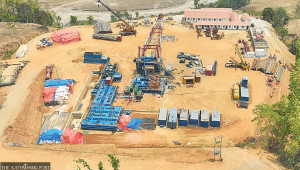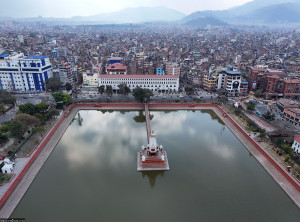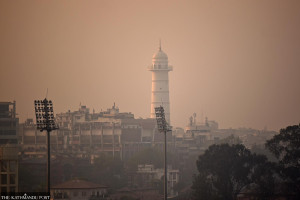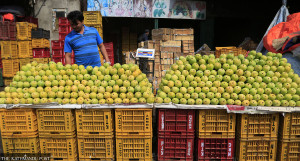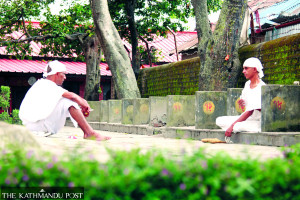Culture & Lifestyle
The pandemic is testing Nepal’s stand-up comedy scene
With no in-person comedy shows, Nepal’s stand-up comics find themselves in unchartered territory.
Tsering Ngodup Lama
On last year’s Valentine’s Day, stand-up comic Prasiddha Dawadi performed a 20-minute set to an audience of mostly young couples at a venue in Jhamsikhel, Lalitpur. On that day, Nepal had only one known covid-19 case but the fear over the novel infection was already causing people to adopt caution and avoid crowded places.
After Dawadi finished his performance, he had an ominous feeling that he wasn’t going to be doing stand-up comedy shows for some time.
A little over a month later, on March 24, 2020, Nepal went into a lockdown.
“Like most people, I thought that in a few months’ time, things would return to normalcy. But I was so wrong. I haven’t done a single in-person live show in more than 17 months now,” says Dawadi.
Before the pandemic took hold last year, stand-up comedy culture in Nepal was growing and becoming increasingly popular. By the end of 2019, Kathmandu was hosting more stand-up comedy shows and open mics than ever. Comics were also doing shows in cities such as Biratnagar, Butwal, Chitwan, Jhapa, Pokhara, etc. But the pandemic has brought a halt to the growth and forced comics to rethink and reimagine how they do stand-up comedy in a world gripped by pandemic.
It was 2018 when Dawadi first began doing stand-up comedy. Kathmandu’s stand-up culture was at a very nascent stage and comics like Dawadi were beginning to explore the possibilities and testing comedic waters.
“When I entered the scene, there were less than 10 stand-up comics. It was a very close-knit community and everybody knew each other personally,” said Dawadi. “At the start of 2020, there were around 30 active stand-up comics and around 10 of them were doing really well.”
Based on how 2019 was for the stand-up comedy scene in the country, 2020 was definitely looking like another year of more growth for the stand-up comedy scene, says Rajina Shrestha, who began doing stand-up comedy in 2018 and is one of the few active female stand-up comics in the country.
“I personally know of some comics who were working on doing their own solo shows in 2020, and doing solo shows is a big thing,” says Shrestha. “Nepal’s stand-up comedy culture has come a long way since its early days in 2018.”
Unlike countries that have dedicated comedy clubs that host stand-up comedy shows and provide a platform to promising new comics, the Kathmandu of 2018, didn’t have any platform for aspiring comics.
The community, says Shrestha, took it upon themselves to bring stand-up comedy to the people. At the time, many restaurants, pubs and bars in the city had live music shows to entertain and attract patrons.
“So we began approaching restaurants, pubs and bars and requested them to host stand-up comedy performances. But back in 2018 and early 2019, stand-up comedy wasn’t as well known as it is today,” says Dawadi. “Many restaurants didn’t really think of stand-up comedy as a viable form of entertainment.”
A handful of restaurants, says Shrestha, did agree to provide stand-up comics with a platform.
“Until mid-2019, comics were performing at a few restaurants, pubs and bars, and as payments, these establishments provided comics with free food,” says Shrestha. “Around the same time, popular YouTube channels such as The Storytellers, Nep-Gasm, Viewfinders, also started giving comics a platform, and stand-up comedy started gaining attention. By the second half of 2019, restaurants, clubs and bars were paying comics money to perform.”
Dawadi fondly remembers his first paid stand-up gig.
“It was in 2018 and I had just begun dabbling in comedy. A newly opened restaurant in Dhumbarahi got in touch with me and asked me to perform two sets. I was paid Rs 500. Even though the amount was very little, that experience made me realise that one can make money from stand-up comedy,” says Dawadi, who now charges around Rs 8,000 per show.
Before the pandemic hit, Dawadi performed at open mics and did at least one comedy show a month.
“At stand-up comedy shows, people come specifically for comedy and there is often an entrance fee,” says Dawadi, who works as a full-time multimedia content creator. “But open mics are mostly hosted by restaurants and pubs and comics use the platform to test their new jokes and the audience members are mostly people who come to the establishments to eat and drink.”
Before the pandemic took hold, says Shrestha, three restaurants hosted open mics every week.
“‘Beers n Cheers’ in Pulchowk, ‘Paral’ in Maitidevi and ‘Dancing Yak’ in Thamel hosted open mic once a week,” says Shrestha. “By late 2019, open mics were already quite popular and there were people who came specifically to attend open mics.”
But the pandemic, says Shrestha, has forced everything to a grinding halt.
In 2020, as the pandemic forced most parts of the world to come to a stop, comics from across the world were forced to adapt to the changing times and many started doing live virtual shows. Comics in Nepal also followed suit, but the transition has been anything but smooth.
“As a comic, you feed off the energy of the audience. When you are performing on a stage in front of a live audience, you get instant feedback on your jokes and that’s really important. You gauge the audience’s reaction and make changes accordingly,” says Dawadi. “But virtual shows are a whole different ball game and they come with their own sets of challenges. With virtual shows, you don’t get instant feedback. And in a country like Nepal, where internet connection is not the most reliable, there is a real risk of your audience not understanding your jokes because of internet latency issues. Audiences on virtual shows also often disrupt performances by talking and making comments in the middle of the show, and comics can’t even turn off audience members' mics because then you don’t get to hear their laughter.”
When organising live comedy shows, organisers, says Shrestha, focus a lot on seating arrangements. “Seating is arranged in such a way that people are seated close to each other so they get influenced by each other's laughter,” says Shrestha. “But when it comes to virtual shows, this is impossible.”
Another challenge of virtual shows in Nepal, says Shrestha, has to do with the financial aspect.
“People here are not very open to paying for virtual shows unless they are charity shows. Comics are still getting used to virtual shows and we are still figuring out how to make the best out of it,” says Shrestha. “Virtual platforms also offer immense opportunities. Yozana Thapa Magar, a stand-up comic, actually opened one of the virtual shows of a famous Indian comic Daniel Fernandes, which is a big deal for a Nepali stand-up comic.”
After more than 10 months of no in-person shows, in early 2021, as Nepal started seeing a considerable decline in the number of daily cases, people began hosting comedy shows once again.
“In January, a comedy show was hosted in Birgunj, and in the following weeks, a few stand-up comedy shows were organised in Kathmandu as well. I performed two shows in March, my first since February 2020,” says Shrestha. “Doing a live show after more than a year was definitely overwhelming, and I had almost forgotten the thrill of seeing people laugh and enjoy my jokes. It was great to be back on stage.”
But just as things appeared to be heading towards normalcy, Nepal was hit by the second wave of the pandemic. In April, many parts of Nepal went into a lockdown.
“Before the pandemic, there were a few comics who were doing shows regularly and were quite successful. The pandemic has hit them the hardest. Many of them are now doing podcasts, making YouTube videos and exploring other platforms to continue doing comedy,” says Shrestha.
In June, the country began lifting the lockdown and some semblance of normalcy has returned. But Dawadi, who hasn’t performed on stage in front of a live audience since February last year, says he is cautious about performing again.
“I don’t think I am ready yet to do live shows again. Given that the number of daily cases is still high, one can’t help but think about the health risks involved in doing live shows,” says Dawadi. “As a comic, one thing this pandemic has made me realise is that I have to be ready to perform on any kind of platform. At the end of the day, as a stand-up comic, you have to be a good performer and be able to make people laugh. As long as comics can do that, things are going to work out.”




 20.57°C Kathmandu
20.57°C Kathmandu











